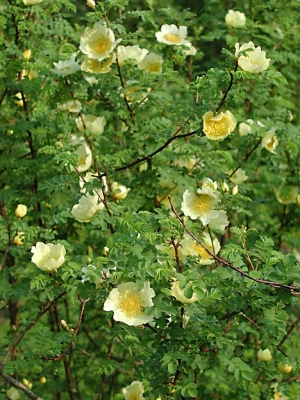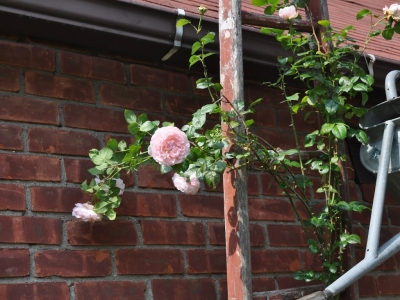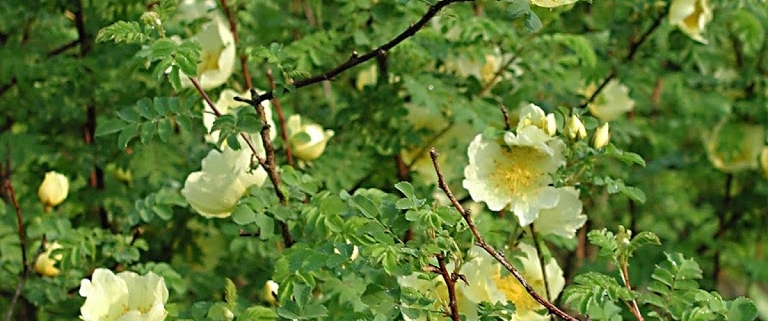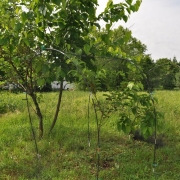A Rose is a Rose is a Rose . . . Not!
Perhaps it was youthful rebelliousness, but for years, for decades, I lambasted my father’s roses. The roses reared up their colorful heads on the other side of the low, clipped privet hedge that bordered our terrace. If youthful rebelliousness was at the root of my rose aversion, that rebelliousness has lasted well beyond my youth, right up to the present day even though those roses are no more.
The plants were hybrid tea roses, in various colors. You’ve got to admit that the shrubs themselves, typically with a few gawky stems topped with disproportionately large blossoms, are not much to look at. The pointiness of the blossoms, a sought-after quality among hybrid tea breeders, is, for me, particularly unattractive. Couple that with the blaring colors and you get the picture, for me, that is.
Hybrid tea roses are not particularly tough plants, succumbing to insects, diseases, and winter cold. Which is why my father grew them practically as annuals, often having to replace dead bushes with new ones. What a waste.
——————————————
Times change, and over the last few years I’ve become a fan of roses. No, not hybrid tea roses! Other types of roses, of which there are many.
Here’s my criteria for a worthy rose (not necessarily in the order of importance): Insect and disease
 |
| Father Hugo’s rose |
resistance; a full-bodied, corpulent shrub; cup-shaped or single flowers; pastel colors; fragrance; and repeat-blooming. Hybrid tea roses generally lack all these qualities, except for repeat-blooming.
Some species and old-fashioned roses tend to have the qualities I seek. Father Hugo’s rose, Rosa hugonis, is one such rose with single, small, soft yellow blossoms and ferny foliage. It’s supposed to be a tough rose, but mine hasn’t yet lived up to that billing. Too much weed competition, perhaps.
Rugose rose (R. rugosa) is another outstanding rose, this one living up to its reputation for being tough. So much so that it’s considered invasive in some places. Still, I like it for its nonstop blooms of single, usually pink-red flowers, its strong fragrance, and its nice hips — fruits that is, very tasty.
If I had to choose just one rose to plant, that rose would
 |
| Rose de Rescht |
be my old-fashioned Rose de Rescht. Its petals are soft cerise in color, and are crumpled like crêpe paper with just a bit of organization on the ends of flower stalks. The fragrance is heavenly, to my nose the best of any rose.
Some modern roses — but not hybrid teas! — have also
 |
| Apricot Knock Out rose |
won me over to my father’s camp.
One such group of moderns are the Knock Out® roses. Very unclassical in appearance, with short, wide stature and mostly single-petalled flowers, these roses are tough and carefree, and bloom all season long. The colors would be gaudy except for their being pleasantly subdued by the small size of the flowers and their lush and abundant backdrop of glossy, green leaves.
 |
| David Austin L. D. Braithwaite |
The other modern roses that have won me over are the David Austin roses, all bred with the goal of combining the look and fragrance
 |
| David Austin Strawberry Hill |
of the old-fashions with the repeat blooming and pest resistance of the moderns. Right now, Strawberry Hill and L. D. Braithwaite are growing very well in my garden, partly the result of a very mild winter.
——————————————-
My father eventually came around to my way of thinking and gave me free rein to rip out his hybrid tea roses and replace them with a mix of other perennial and annual flowers. The view from the terrace was transformed into a spring through autumn panoply of colors and forms from the likes of tree peonies, ligularias, lungwort, bleeding heart, and other perennials. The one constant following the transformation was the line of begonias or marigolds that marched along the edge of the bed, just as they did when the bed was home to roses.
——————————————
Mulberries have ripened, so a taste test was in order: Illinois Everbearing vs. Oscar vs. Kokuso vs. Gerardi Dwarf vs. random seedling. Oscar was best with Kokuso and the seedling a close second, followed by Illinois Everbearing and then Gerardi Dwarf. These ratings aren’t writ in stone, for me, because confounding everything were big flavor changes that depended on slight changes in ripening — I think.
Note that black mulberry — the species Morus nigra — was not in the running. That’s because the fruits won’t be ripe for awhile and because, I know from experience, it’s far and away the best of them all.







Most of the places I look to find black mulberries offer them as hardy to zone 4 or 5. Is this mistaken, prevarication, or are there some new, super-hardy varieties out there? If there are, I want some.
BTW, most of these places specify Morus nigra, so they shouldn’t mean just “mulberries that are black”.
I think they’re wrong. Everything I’ve read from the past century indicates that M. nigra is not hardy beyond Mediterranean climates. I hope we’re all wrong. As I wrote previously, I did graft a branch of M. nigra onto a mulberry seedling growing outdoors here in Zone 5. The graft has taken. We’ll see how it looks next spring.
lee, would a knock out rose or a rugoso be a good choice for training near a rock wall for a good pop of color and texture?
Yes, either would be good. Rugosa spreads a little by underground runners, which could be good or bad, depending on the site.
I don’t think you have Rose de Rescht, a plant that was once fancifully (and somewhat hyperbolically) described as “a sturdy, yard high bush of glazed lizard-green, perpetually emblazoned with full camellia flowers of pigeon’s blood ruby, irised with royal purple, haloed with dragon sepals like the painted blooms on oriental faience.” Yours looks to be a lighter pink and the bush and flowers look too big and leaves too small, judging from what one can make out from the photo. It is very nice, though, whatever it is. Old roses are the best!
I do have Rose de Rescht and although I love it (partly because of the extravagant description in old books), the “lizard-green” leaves do get a diseased appearance as the summer wears on. I have seen and smelled specimens that were very fragrant. Mine isn’t — perhaps my city garden is too windy. But the small (2″), round (almost magenta) flowers set in among the large light green leaves are quite distinctive.